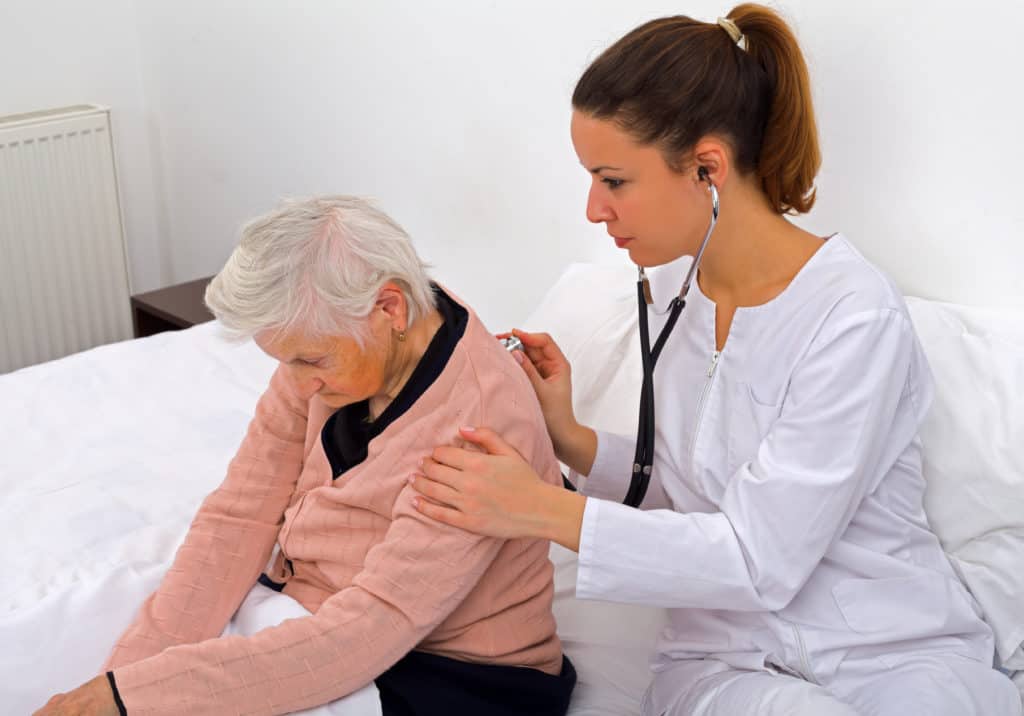Over the past few months, these two words have been among the most heard and written. Bilateral pneumonia, from being just another disease, has become very present in our lives as a consequence of COVID-19.
In this article we expose the main aspects of it:
What is bilateral pneumonia?
Bilateral pneumonia is an inflammatory type reaction that occurs in the lung tissue. It can be due to an external aggression caused by a microorganism. Which can be a virus, a bacterium or even a fungus. Among them, the most common in adults are bacteria.
The surname of bilateral, as its own name means, refers to it being “of the two parts”. That is, it affects both lungs, experiencing in both an inflammation. Within these organs, we have hundreds of millions of alveoli. Through them, the exchange of oxygen with the blood takes place. The oxygen obtained by inspiration enters the blood cells (i.e., the entire body). In a patient suffering from bilateral pneumonia, the exchange of gases is altered.
This disease is especially dangerous for people over 65. Proof of this is the number of senior citizens who have died from COVID-19.
Symptoms of Bilateral Pneumonia
The symptoms that patients with bilateral pneumonia experience are as follows:
Difficulty in breathing.
Intense fever and sweating.
Chest pain when breathing or coughing.
Disorientation or changes in mental perception (especially noticeable in older people)
Coughing with phlegm that does not get better.
Sweating or chills.
Difficulty breathing.
Nausea.
Vomiting.
Lower than normal body temperature.
Loss of appetite.
Fatigue or tiredness.
Decreased mental awareness.
Muscle and joint pain.
General discomfort.
Complications
Bilateral pneumonia infection causes severe respiratory failure and can eventually spread to other areas and organs of the body.
The most common complications of pneumonia are
Low levels of oxygen in the bloodstream
Low blood pressure.
Lung abscess (pus-filled cavity in the lung)
Severe lung injury: acute respiratory distress syndrome (ARDS).
Bacteremia – Bacteria entering the bloodstream can spread the infection to other organs
As the lungs become inflamed, breathing capacity decreases and the patient becomes severely ill, because, in addition to the alteration caused by this lack of oxygen in the lungs themselves, this lack extends to the entire body. Because of this, the patient needs aggressive measures, among which are invasive mechanical breathing. In this action, an essential device is the respirator.
In this way, if the patient with bilateral pneumonia cannot breathe on his or her own, a tracheotomy is performed and a tube inserted. This tube connects to the ventilator. A device that introduces and extracts air from the lungs thanks to the control of a microprocessor. Its purpose is to provide a constant volume of oxygen so that as many pulmonary alveoli as possible are kept ventilated and open. Without the ventilator, the patient dies. They are essential to prevent him/her from falling into serious respiratory failure and eventually dying.
Recovery
Even if you are discharged from the hospital, it does not mean that you are completely cured. Recovery from bilateral pneumonia is not immediate.
This is a relatively long illness in which patients may suffer symptoms for weeks after being discharged. Thus, the cough will slowly improve, but it may remain for up to 14 days, sleep and diet will still be altered, and the energy level will remain at very low levels for at least two more weeks.
Therefore, when our family member arrives home, he or she will need the permanent attention of a caregiver who knows how to care for his or her condition. In Nomenial we select professional caregivers with experience and knowledge about this pathology. Through their care, the patient will be able to enjoy a simpler and more satisfactory recovery and the family will have the peace of mind and security that their relative is in the best professional hands.
It should also be noted that bilateral pneumonia can have a long-term effect, since patients who have suffered it are at greater risk of suffering cardiovascular problems in the next 10 years.
In order to avoid the progression of the disease towards a serious state. Subsequently, the sequelae are greater. The primary thing is to go to the doctor as soon as we present the symptoms described above. The specialists agree that the diagnosis that the primary care physician makes will be fundamental for the good evolution of this condition. Since it is from this evaluation that the treatment that the patient must follow to confront the pulmonary problem that he or she presents will be determined.
Severe bilateral pneumonia
In severe bilateral pneumonia, the lungs stop saturating the blood with oxygen and the person can die within hours.
In this severe scenario, the lung turns into a fluid-filled sponge. The alveoli fill with an infiltrate that consists of cell debris, bacteria and immune system cells.
In this type of clinical picture, a considerable number of patients who suffer from it often suffer sequelae with which they must live all their lives, such as pulmonary fibrosis.
The latter is a condition that occurs when the lung tissue is damaged and scars form, causing the lungs to be unable to function properly.
Although there is no cure for this condition, specific medication and care can help relieve the symptoms and increase the quality of life.
Bilateral Pneumonia with Pleural Effusion
The pleural space is the space between the lungs and the thorax. To lubricate the surfaces of the pleura, our body produces pleural fluid in small amounts. This health problem consists of an excessive accumulation of this fluid.
Pleural effusion can be of two types:
Transudate: originated, in most cases, by heart failure.
Exudate: Of more diverse origin than the other type, the most frequent causes are pneumonia, tuberculosis or tumors in the lungs.
Bilateral pneumonia with pleural effusion is part of this second type and for its treatment antibiotics will be assessed as one of the most effective options.
Is bilateral pneumonia contagious?
Many people have asked this question.
There are both contagious and non-contagious pneumonias. The cause of the pneumonia is the determining factor in whether or not it is contagious:
Viral Pneumonia: they are generally contagious. But it is necessary to clarify something important. Pneumonia is not contagious, but the agent that causes it is. That is to say, the patient is not contagious of bilateral pneumonia, but of the own virus causing the same one.
Bacterial pneumonia: they are not contagious in most cases, but there are some exceptions. The bacteria that causes it can be transmitted to others, but they may not end up developing pneumonia.
Pneumonia caused by fungi or parasites: they are not directly transmitted from one person to another.
In this context in which we find ourselves, we must maintain the alert that we have not abandoned during the last months. Bilateral pneumonia in senior citizens can lead to irreparable sequelae that will limit their quality of life or, in the worst case, can be fatal. Therefore, it is important that we protect senior citizens and that they continue to stay away from any risk of contagion. To achieve this, it is vital to follow preventive medical recommendations, such as the use of masks and continuous hand hygiene, as well as avoiding crowds and inadequate contact with both strangers and family members.
In Nomenial we have committed ourselves to the care of our older relatives. We have carried out an exhaustive selection process of carers, with which we have minimized any risk and, as always, we have managed to provide the best care.







